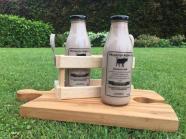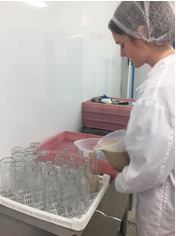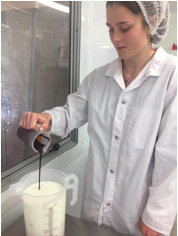Top scholar technology 2017: Kapakapa buffalo milk

Hayley Rutter developed a chocolate and vanilla flavoured buffalo milk for premium health conscious buyers, with the Whangaripo Buffalo Cheese Company (WBC).
Scoping the market
Chocolate flavoured milks are popular in consumer markets however generally have a high sugar content. Kapakapa natural chocolate and vanilla flavoured milk, a buffalo milk product, has no added sugar.
Interested in developing a product for premium health conscious buyers, Hayley examined companies in this market who could also mentor her in the project.
Mentors

A letter of approach, outlining the scholarship project and considerations, was delivered to the Whangaripo Buffalo Cheese Company.
As a result of this approach the family agreed to mentor Hayley.
Phil and his wife Annie Armstrong-Wills and family operate the WBC from their home at Dairy Flat, north of Auckland.
Hayley carried out a broad overview of resources such as ingredients and materials, finances, time, equipment, skills and experience available and then arranged to meet with Annie and Phil Armstrong.
Throughout her project Hayley demonstrated a high level of sensitivity to the time demands and commitments of her business partners.
Testing, prototyping, trialling
Product disassembly involves looking at existing products in the market and reviewing these to guide new development. This proved to be an effective strategy to clarify the composition necessary for a new product in the flavoured milk market.
Testing
A variety of chocolate flavour combinations found in chocolate bars were tested on stakeholders to determine favourites. Carob was explored as an alternative to chocolate. The perceptions of consumers of carob as a substitute for chocolate were also researched.
Flavour trends for food and beverages confirmed that a carob flavoured milk drink could appeal as consumers were looking for natural flavours – both familiar and unusual.
A fellow student who had work experience with International Flavour and Food Ltd, learning about flavouring food products, guided Hayley with how to efficiently trial flavourings, reducing ingredient wastage.
Prototype development

Conceptual designs were developed for milk flavours. Nine trials were carried out at various stages in the prototype development stage.
Trialling
The final two varieties of bottled and labelled carob flavoured milk (with and without sugar) were tested at the The Dairy in Ponsonby, central Auckland.
The target market of high-end, health conscious consumers were known to frequent this venue. Surveys and customer feedback completed on the day indicated that the variety with no sugar was the favoured product.
Food safety and codes of practice


Milk is high risk for food poisoning. Pasteurisation of milk is necessary to ensure consumer safety.
WBC uses a batch pasteurisation process with a jacketed vat. Regular audits of the milk are carried out by sending samples to laboratories for testing microbial content and milk composition. This ensures that the milk is consistently safe to consume.
The company operates a risk management plan for the production process of their buffalo milk products.
WBC supply both unpasteurised and pasteurised milk to their customers and Hayley had the choice of which to use for her own development. It was determined safer to use pasteurised than to try and mimic this industrial process in a classroom setting.
- The milk was not processed to standardise each batch and nor was it homogenised. This meant that the bottle required shaking to distribute the cream.
- The milk was not organic certified but the company is able to claim that it is organically farmed. Sprays and chemicals are not used on the land and palm kernel and supplements are not fed to the buffalos. These farming practices enable access of their products to specialised organic stores.
Hayley sought advice from a food technologist on when to add the flavour – before or after pasteurisation – so that the product was safe as well as appetising.
After a number of trials to ensure an optimum flavour profile the final product was made at the WBC factory, with the flavour added after pasteurisation.
Product branding
Labelling

Hayley developed a label alongside Annie and Phil that was in keeping with her vision of a brand with a vintage feel, which was currently trending with similar market products and met company branding requirements.
The label included a nutritional analysis of the final product. The product was also promoted on the basis that the buffalo milk is lactose free and has a base of A2 protein, which is considered suitable for an A1 protein intolerance.
Product design
The elegance shown in the simple composition of the final product belies the extensive research, testing, trialling, and critical reflection that went into its development. Elegance and simplicity is an outstanding scholarship concept.
Scholarship performance criteria
Convincing communication is one of the performance descriptors for outstanding scholarship in technology. Hayley used a variety of techniques to communicate her practice:
- annotations on extensive market research with succinct reflections
- visual presentation of conceptual designs
- survey samples with annotation on the rationale behind each question
- survey result summaries with reflections
- a clear executive summary of the project.
Student voice and independence in decision making and ongoing project management is another criteria apparent in the portfolio, particularly as the project developed.
“Demonstration of sophisticated integration and abstraction in a sustained manner” is an outstanding scholarship performance descriptor exemplified by Hayley’s extensive trialling and subsequent responses to the results.
Fitness for purpose
Fitness for purpose in its broadest sense relates to the outcome itself as well as to the practices used to develop the outcome. This is a curriculum level 8 concept and is referred to in the generic achievement standards at NCEA level 3.
When developing this product Hayley considered many relevant aspects of this concept.
-
Sustainability of resources:
The milk was bottled in glass and part of a returnable system already in place at WBC. -
Health and safety:
The milk was pasteurised by the company in preference to Hayley carrying out pasteurisation in a classroom setting. When producing her final samples at the factory, Hayley complied with all safety requirements. -
Ethical nature of testing practices:
The milk was safe to consume throughout the trialing as it was locally supplied and produced by a company compliant with NZ health and safety and labour laws.
What's next
Hayley is studying to be a physiotherapist at Auckland University of Technology.
She is using her food technology expertise in a part time job promoting food products for companies by offering samples and tastings.

